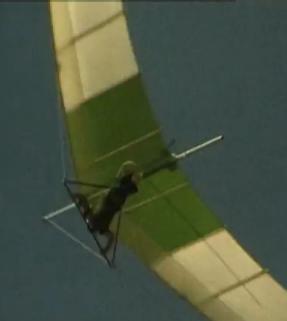
Miles Handley Gulp flown by Johnny Carr ( www.johnnycarr.com ).
He is still active in the UK and an agent for AirBorne and Aeriane gliders. ~Arp
Seven Compression (7C)
Home
Your notes are welcome: Editor@UpperWindpower.com
This page:
http://www.energykitesystems.net/7C/index.html
Most recent edit:
Wednesday
October 24, 2012

Miles Handley Gulp flown by Johnny Carr (
www.johnnycarr.com ).
He is still active in the UK and an agent for AirBorne and Aeriane
gliders. ~Arp
Seven Compression (7C)

|
7C
:: Seven Compression Members for Kite, ParaGlider Hang Glider Cable-braced airframe. Crossboomless. No crossboom. No cross-boom. No cross-spar. No bracing beam. |
|
Bartolini and his patent Discussion is welcome. |
|
The seven compression members: LB, RB, BS, Spine, KP, LQP,
RQP
The seven compression members: left beam,
right beam, bowsprit, spine, kingpost, left queenpost, right queenpost |
|
Koman-Faust, Gryphon, Pere Casellas, Tony Prentice, Eddie Paul, Dial
Ship,
GNU-PORTA-GLIDER, Pere,
Dec. 28, 2011.
I include the Porta-Wing in the 7C
family; Eddie Paul integrated the left beam with the right beam.
He integrated the bowsprit with spine. He chose to have
aerodynamic leading edge on a stay cable rather than on the left and
right beams. Thus, the
http://www.laboratoridenvol.com/projects/gnuportaglider/index.en.html
is in the 7C
family.
JoeF
The Koman-Faust was not with sweep. About 12
yr later one sees the
http://www.flickr.com/photos/ |
|
Joe,
Dec.
18, 2011
> Pere,
> ... Lift and I need lifts as you give; assume our forgetfulness and > share what is interesting on you mind. So glad for the Gryphon reminder. > The strategy base in the structure has not been fully explored yet in hang > gliding. As you mention, the age of invention is yet to be! > > For January LIFT: > The Koman-Faust was not with sweep. About 12 yr later one sees the > http://www.flickr.com/photos/ > Wasp gryphon Hang Glider ~ Don Liddard > Waspair Gryphon G160 span 32'3" nose angle 138 deg 160sq ft {14.86 sq > mtrs} weight 22.67kg {50lb}. Feature: Bowsprit, kingpost, two queenposts > (downtubes) in the triangle control frame (TCF) format to obtain bracing > that ends without a cross spar; the leading edge tubes act as wing spar > both in the non-sweep early 1970's Koman-Faust Dial ship and in the Waspair Gryphon. Thanks to * Pere Casellas http://www. >
* for reminding links.
> > On Tue, Dec 27, 2011 at 2:00 PM, Pere Casellas <pere@laboratoridenvol.com> > > http://www.flickr.com/photos/ |
Fuzzy ideas:
|
|
Miles Wings: the
Gulp
Re: Miles Handley Don Liddard has a series of very neat photographs on the Miles Gulp: See: HERE
|
Mere 1978
BHGA Hang Glider Competition Event
You must have a look: john stokes at 05:03, and Dave Lewis at 06:07 Don Liddard Film of the 1978 Hang gliding meeting at Mere has turned up. Some shots of the Wasp Gryphon (bowsprit) which wins the distance event. Tony |
|
Some hang gliders use a bowsprit, rather than a spar to spread their wings. The bowsprit is formed by extending the keel tube about a metre beyond the leading edge of the wing. In 1879 a patent in England by F. W. Brearey was filed (followed by U.S. patenting in numbers 234947 and 320042) that taught bowsprit structure for flying machines. In the modern mid-1900s renaissance in hang gliding a Dial Soap TV commercial featured in 1973 a[1] bowsprit cross-sparless hang glider. Other examples of bowsprit hang gliders were exampled in the gliders manufactured by Bautek in the 1980s[2]. |
| [ ] We at LIFT have received drawings and photograph of the MK1 Splitwing by Tony Prentice. The four items will be up soon. There are no formal test results for regarding safe loadings. And we will link to some historicals regarding the same. |
|
Hang Gliding fun with a 7C wing: |
|
Ultralight Products Mosquito with story and photos by Richard Cobb at his site. |
|
|
|
News, notes, documents,
files:
Editor@UpperWindpower.com
~~Kite Energy
Community~~